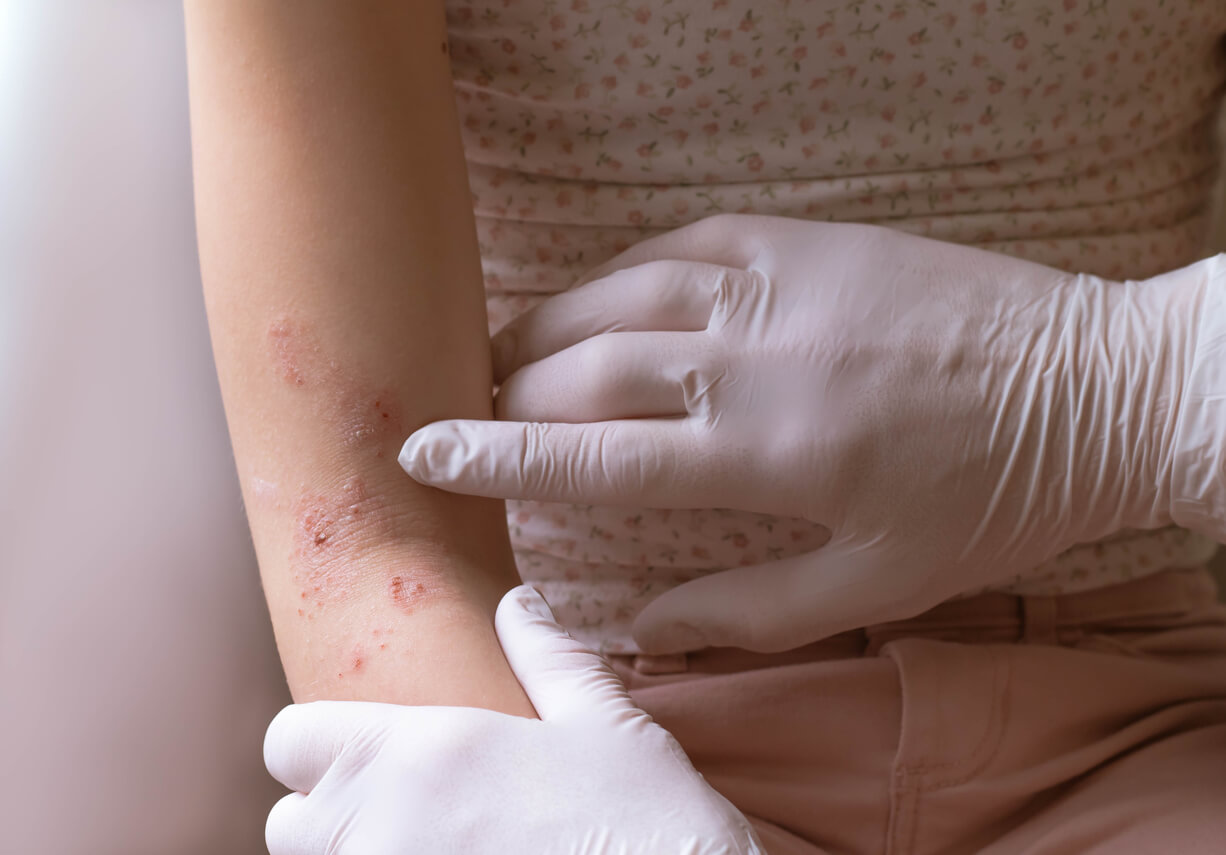One out of every four Americans has some form of skin disease. If you’re experiencing the discomfort of a skin rash, you are included in this statistic.
Let’s take a look at some common skin rashes adults develop, and where you can go in the Greater Athens area for quick and effective treatment of skin issues of all kinds.
Rashes that Are Common in Adults
You are in good company if you have one or more of the following types of skin rashes:
Eczema
This persistent skin rash affects approximately 35 million Americans. Its symptoms include itchy, red, rough-textured skin patches on the:
- Face
- Arms
- Legs
- Chest
- Back
Areas of perspiration, such as the armpits, inner aspects of the elbows, and backs of the knees can also develop this skin condition.
Eczema appears to be linked to the body’s immune system, and it’s often triggered by:
- Dry skin
- Contact with certain irritants (fabrics, plants, cleaning chemicals, soaps, etc.)
- Stress on the body from asthma, allergies, illnesses, or even the change of seasons
Most people with eczema have it for years, experiencing periods of increased symptoms and remission. People who have darker skin tones notice a purple to brown color to their eczema, and dry skin can have an ashy appearance.
Treatment includes keeping the skin moisturized. See your dermatologist for prescription cream or other treatments that can help clear the rash and control the itch if moisturizing alone does not help. It is also best to avoid things that tend to irritate your skin and cause your symptoms, and to stay as cool as possible during the warm summer months.
Rosacea
Rosacea is a very common skin condition that tends to affect people who are in the 30 to 60 age group. It causes redness, bumps, or pustules across the cheeks and nose. Tiny, visible veins may also appear. Rosacea comes and goes with various triggers.
To avoid breakouts of rosacea, your dermatologist may ask you to limit sun exposure, heat, certain foods and drinks, and irritating skin care products. There are several creams used to treat the bumps of rosacea or to reduce redness. Occasionally antibiotics can help to control severe flares. In-office laser therapy can be performed to reduce the visible blood vessels on the face.
Shingles
Although shingles can affect any area of the body, such as the eye, it usually appears as a rash across the middle torso. The indicator that it’s shingles is that the rash only goes across one half of your torso, stopping at the belly button line and mid-back. It has a characteristic tingling or burning sensation.
Shingles pain is a result of nerve inflammation, and it can last for weeks – so it is important to see a doctor immediately for diagnosis, treatment, and prescription medication to clear the rash up faster, as well as to prevent the nerve pains from lasting long after the rash clears.
Shingles impacts one out of every three people aged 50 or older. The infection is caused by a virus which has remained dormant in your system from having chicken pox in the past. This is why healthcare providers recommend the shingles vaccine to all middle-aged adults, even if you have had shingles.
Pityriasis Rosea
This very common, benign rash gets less media attention than the other skin conditions discussed here, but millions get it annually. Thankfully, pityriasis rosea resolves on its own, causing no long-term skin or systemic health issues. It tends to happen to people who are 35 or younger.
The symptoms of pityriasis rosea include:
- A large, itchy, red oval on your skin, followed by many smaller red spots
- The spots together often resemble a Christmas tree pattern (like pine branches)
- Appearance on the back and chest
- Gradual resolution within weeks
This skin rash requires no medical treatment beyond relief of itchiness with over-the-counter anti-itch creams or ointments. Keeping the rash moisturized is important in order to prevent the rash from becoming dry, cracked, and infected.
Psoriasis
Characterized by thick, itchy, reddened plaques, psoriasis is well-known for its rapid onset and stubborn retention of excess skin cell growth. Autoimmune in nature, this chronic skin problem flares up and subsides, often in response to stress, cold temperatures, smoking, and other factors.
For as many as 30% of psoriasis sufferers, psoriatic arthritis can develop along with the skin manifestations. Psoriatic arthritis causes joint stiffness and a fair amount of pain.
Psoriasis may be classified as three broad types:
- Guttate psoriasis, triggered by a strep infection and mostly presenting as small, drop-like lesions on the scalp, trunk, and extremities
- Pustular psoriasis, characterized by widespread pus-filled blisters, or isolated on the feet and hands or other area of the body
- Plaque psoriasis, the most frequently occurring kind, which presents with silvery, dry, bumpy scales
Treatment for psoriasis is highly individualized. Some people respond well to topical medications, and others do best with treatments delivered by mouth or injection. Your dermatologist will help you decide which options are best for you.
Dermatology Care in the Greater Athens Area, Georgia
At Georgia Skin Cancer & Aesthetic Dermatology, our board-certified skin doctors are Dr. Ross Campbell and Dr. Kristen Thomas. When you come to one of our locations in Georgia – Athens (Watkinsville), Commerce, Elberton, Gainesville, Lake Oconee, or Winder – you’ll receive the finest in dermatology diagnostics and treatment. Plus, we cater to the aesthetic side of skin care, too.
Contact us today if you wish to address a skin rash, acne, wrinkles, or skin discoloration, or if you would like a skin checkup. We can be reached at (706) 543-5858 or through our appointment request form online. We look forward to being your dermatologist!
